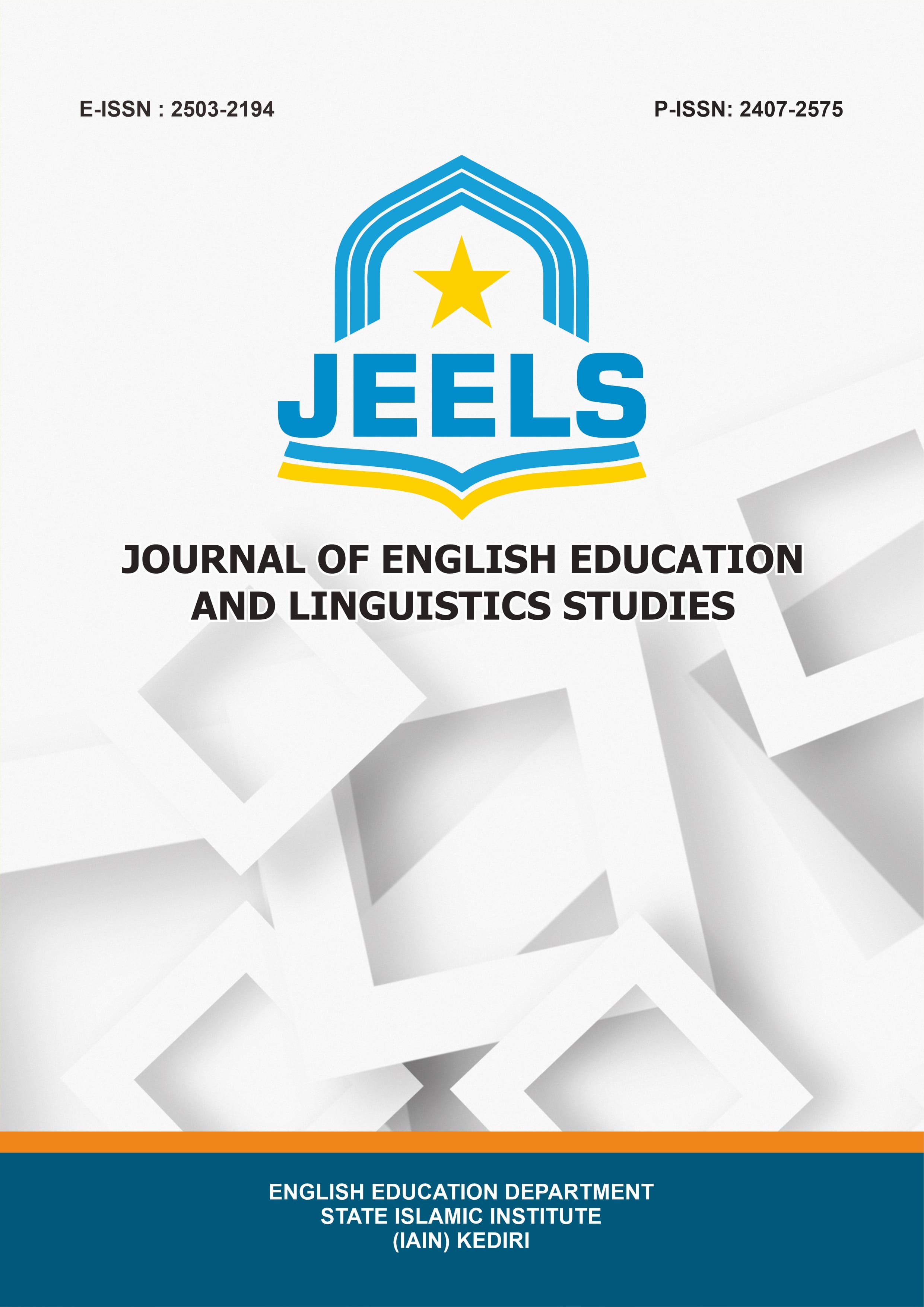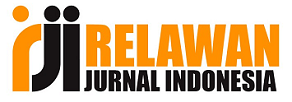Students' Voices on Effective Teaching Methods for Grammar Learning in Peer Tutoring Program
DOI:
https://doi.org/10.30762/jeels.v11i2.2904Keywords:
grammar tutoring program, students' perceptions, grammar teaching methodsAbstract
This research investigated students’ perceptions of tutors’ teaching methods applied in one of grammar tutoring classes in an English Education study program at one of the universities in Yogyakarta. The students’ preferences on grammar teaching methods were also discovered. This research employed a quantitative approach. Fifty-seven students participated in this study and filled out the questionnaire. Their activities during tutoring program were observed. Then, the interview was used to gather further information. The result of the questionnaire revealed a mean score of four point twenty-nine. It showed that the participants of this study shared their positive perceptions of tutors’ teaching methods in grammar tutoring classes. They felt that the tutors were able to build a comfortable learning experience and motivate them to have a language exposure. Additionally, the students desired to learn grammar by using the audio-lingual method and communicative language teaching (CLT) method. This study implies the need for a well-prepared peer tutoring program to help students effectively. Additionally, the administrators can address individual learning differences and provide insights for improving grammar instructions.
Downloads
References
Ajisuksmo, C. R., & Vermunt, J. D. (1999). Learning styles and self‐regulation of learning at university: An Indonesian study. Asia Pacific Journal of Education, 19(2), 45-59.
Albaum, G. (1997). The Likert scale revisited: An alternate version (product preference testing). International Journal of Market Research, 39(2), 1–21.
Ali, N., Anwer, M., & Abbas, J. (2015). Impact of peer tutoring on learning of students. Journal for Studies in Management and Planning, 1(2), 61–66.
Allen, G. D., & Ross, A. (Eds.). (2017). Pedagogy and content in middle and high school mathematics. SensePublishers. https://doi.org/10.1007/978-94-6351-137-7.
Alrajhi, M. N., & Aldhafri, S. S. (2015). Peer tutoring effects on Omani students’ English self-concept. International Education Studies, 8(6), 184-193. https://doi.org/10.5539/ies.v8n6p184.
Arco-Tirado, J. L., Fernández-Martín, F. D., & Hervás-Torres, M. (2019). Evidence-based peer-tutoring program to improve students’ performance at the university. Studies in Higher Education, 45(11), 2190–2202. https://doi.org/10.1080/03075079.2019.1597038.
Benitez-Correa, C., Gonzalez-Torres, P., Ochoa-Cueva, C., & Vargas-Saritama, A. (2019). A comparison between deductive and inductive approaches for teaching EFL Grammar to high school students. International Journal of Instruction, 12(1), 225–236. https://doi.org/10.29333/iji.2019.12115a.
Bintoro, S. R. (2016). Students’ understanding of –ing and –ed participial adjective in English Language Education Study Program Sanata Dharma. Sanata Dharma University.
Blok, S., Lockwood, R. B., & Frendo, E. (2020). The 6 principles for exemplary teaching of English learners: Academic and other specific purposes. TESOL International Association.
Cohen, L., Manion, L., & Morrison, K. (2018). Research methods in education (8th ed.). Routledge.
Cochran, W. G. (1977). Sampling techniques. John Wiley & Sons.
Dörnyei, Z. (2005). The psychology of the language learner: Individual differences in second language acquisition. Lawrence Erlbaum Associates, Inc.
Dos Santos, L. M. (2020). The discussion of communicative language teaching approach in language classrooms. Journal of Education and e-Learning Research, 7(2), 104-109.
Ellis, R. (2006). Current issues in the teaching of grammar: An SLA perspective. TESOL Quarterly, 40(1), 83-107. https://doi.org/10.2307/40264512.
Field, A. (2024). Discovering statistics using IBM SPSS statistics. Sage Publications Limited.
Goertzen, M. J. (2017). Introduction to quantitative research and data. Library Technology Reports, 53(4), 12-18.
Hattie, J., & Timperley, H. (2007). The Power of Feedback. Review of Educational Research, 77(1), 81–112. https://doi.org/10.3102/003465430298487.
Hinkel, E. (2006). Current perspectives on teaching the four skills. TESOL Quarterly, 40(1), 109-131. https://doi.org/10.2307/40264513.
Ho, P. V. P., & Binh, N. T. (2014). The effects of communicative grammar teaching on students' achievement of grammatical knowledge and oral production. English Language Teaching, 7(6), 74-86.
Keo, V., & Lan, B. (2024). Exploring language teaching methods: An in-depth analysis of grammar translation, direct method, and audiolingual method: A Literature Review. International Journal of Advance Social Sciences and Education (IJASSE), 2(2), 151–168. https://doi.org/10.59890/ijasse.v2i2.1766.
Krashen, S. D. (1985). The input hypothesis: Issues and implications. Longman.
Larsen-Freeman, D., & Anderson, M. (2011). Techniques and principles in language teaching (Third edition). Oxford University Press.
Male, H. (2016). Understanding inductive and deductive approaches in teaching grammar in EFL context. Jurnal Dinamika Pendidikan, 9(1), 19-24.
Miller, M. B. (1995). Coefficient alpha: A basic introduction from the perspectives of classical test theory and structural equation modeling. Structural Equation Modeling: A Multidisciplinary Journal, 2(3), 255-273.
Murtini, N. M. W. (2021). English grammar mastery of the first semester students. JOSELT (Journal on Studies in English Language Teaching), 2(2), 20–24.
Norris, J. M., & Ortega, L. (2000). Effectiveness of L2 instruction: A research synthesis and quantitative meta‐analysis. Language Learning, 50(3), 417–528. https://doi.org/10.1111/0023-8333.00136.
Nur, S. (2020). Students’ perception toward the use of deductive and inductive approaches in teaching English grammar. TESOL International Journal, 15(1), 6-19.
Obeidat, M. M., & Alomari, M. A. (2020). The effect of inductive and deductive teaching on EFL undergraduates’ achievement in grammar at the Hashemite University in Jordan. International Journal of Higher Education, 9(2), 280–288. https://doi.org/10.5430/ijhe.v9n2p280.
Paragae, I. G. A. P. N. S. (2023). Innovative teaching strategies in teaching English as a foreign language. English Teaching and Linguistics Journal (ETLiJ), 4(1), 1-9. https://doi.org/10.30596/etlij.v4i1.12990.
Raxmonovna, T. M. (2023). Using inductive and deductive approach in teaching grammar. Modern Science and Research, 2, 11–17. https://doi.org/10.5281/zenodo.10076310.
Refat, N., Kassim, H., Rahman, M. A., & Razali, R. B. (2020). Measuring student motivation on the use of a mobile-assisted grammar learning tool. PLOS ONE, 15(8), 1-20. https://doi.org/10.1371/journal.pone.0236862.
Richards, J. C., & Rodgers, T. S. (2014). Approaches and methods in language teaching. Cambridge University Press.
Sembiring, N. (2021). Applying peer teaching technique to improve students’grammar achievement. KAIROS, 5(2), 89-98.
Setiyadi, A. B. (2006). Teaching English as a foreign language. Graha Ilmu.
Shirav, A., & Nagai, E. (2022). The Effects of Deductive and Inductive Grammar Instructions in Communicative Teaching. English Language Teaching, 15(6), 102-123. https://doi.org/10.5539/elt.v15n6p102.
Suhartini, T. (2022). Learning English grammar through audio-lingual method (a case study in Kumon EFL Ranggong, Makassar). JoELS: Journal of English Language Studies, 1(1), 45–55. http://ojs.unsamakassar.ac.id/jel.
Takala, A. (2016). Grammar teaching methods in EFL lessons: Factors to consider when making instructional decisions [Master Thesis]. University of Jyväskylä.
Tan, J. B., & Gevera, E. B. (2020). Peer tutorial: Championing students at risk. International Journal of Learning, Teaching and Educational Research, 19(5), 352-378.
Tanihardjo, J. (2017). A comparative study of deductive and inductive teaching of participial phrase: A case study. Journal of English Language and Culture, 6(2), 123-144.
TESOL International Association. (2018). The 6 principles for exemplary teaching of English learners. TESOL International Association.
Vygotsky, L. S. (1978). Mind in society: The development of higher psychological processes. Harvard University Press.
Wang, S. P., Chen, Y. L., & Tseng, W. T. (2023). Multimodal instruction and mentor-tutoring in an intensive English program. SAGE Open, 13(4), 1-26.
Weigle, S. C., & Nelson, G. L. (2004). Novice tutors and their ESL tutees: Three case studies of tutor roles and perceptions of tutorial success. Journal of Second Language Writing, 13(3), 203–225. https://doi.org/10.1016/j.jslw.2004.04.011
Widodo, H. P. (2006). Approaches and procedures for teaching grammar. English teaching: Practice and critique, 5(1), 122-141.
Zeller, R. A. (2005). Measurement error, issues and solutions. in Encyclopedia of Social Measurement, 665-676.
Zhang, X. (2021). After-class academic support: does course-embedded faculty tutoring matter to student writers? Teaching in Higher Education, 26(1), 129-144.
Zhang, Z., & Bayley, J. G. (2019). Peer learning for university students’ learning enrichment: Perspectives of undergraduate students. Journal of Peer Learning, 12(1), 61–74.
Downloads
Published
How to Cite
Issue
Section
License
Copyright (c) 2024 JEELS (Journal of English Education and Linguistics Studies)

This work is licensed under a Creative Commons Attribution 4.0 International License.










